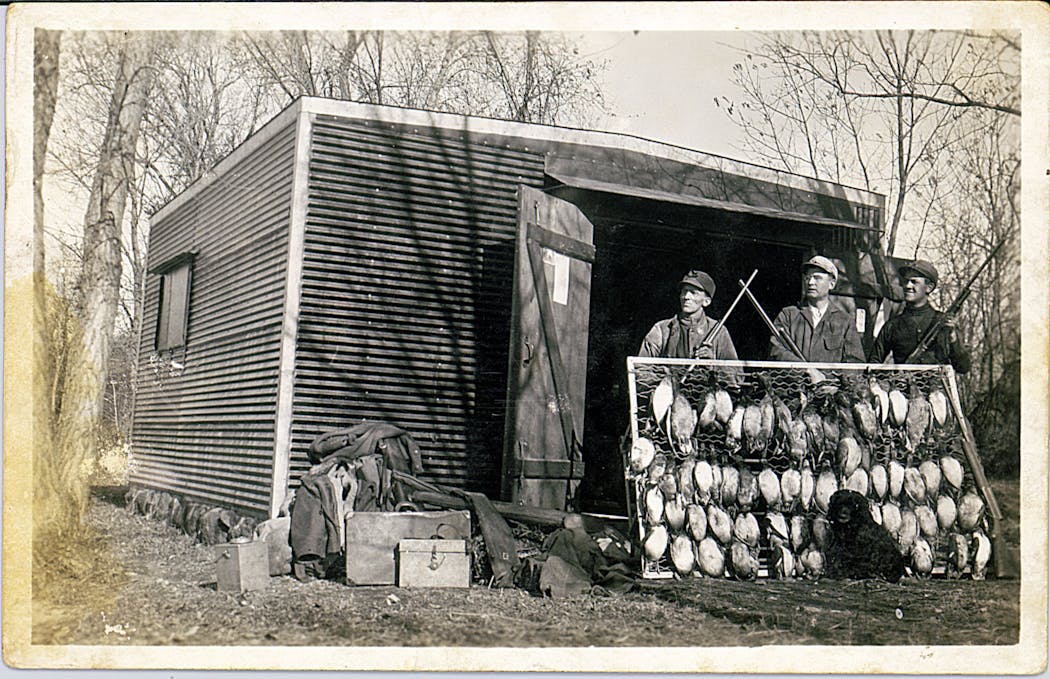LAKE CHRISTINA, MINN. – The other evening, as the sun set over this 4,000-acre shallow body of water that straddles Grant and Douglas counties, Will Smith, Dan Gahlon and I were surrounded by ghosts, watching ducks.
In the middle of the lake, redhead ducks mixed with ringnecks, scattered among which were canvasbacks, while small flights of green-winged teal arrowed above the preening flotilla.
Coots, mergansers and trumpeter swans also were present, the latter, large and brilliantly white, visible from long distances.
The ghosts?
Sam Fertig was one.
In the 1860s, accompanied by his two dogs, Fertig traveled from St. Paul to Christina in a horse and buggy. Beguiled by the sight of the big lake, black with ducks, for the next 40 years he hunted Christina for the market, at times filling his boat with more than 150 canvasbacks and redheads before sending them to restaurants in the Twin Cities and beyond, the redheads bringing $3.50 a dozen, the canvasbacks, $4.
Among Christina's countless other ghosts are those of Anton Wahlin, who founded his duck camp in 1912, and Edward Decker, who first hunted Christina in 1924.
Successful as these and many other waterfowlers were on Christina, by the 1950s the lake morphed from a duck mecca to a murky cesspool nearly devoid of birds. In 1959, only 250 canvasbacks used the lake.
The biggest losers of this devolution were the hundreds of thousands of ducks whose spring and fall stopovers on the lake were — and are — critical to their well-being.
For thousands of years, nearly since the last glaciers retreated, Christina had provided a place for these birds to rest and feed without disturbance during their long and oftentimes perilous seasonal flights.
Algae was clouding the lake, researchers discovered, stunting aquatic plants such as sago pondweed. Wind churning up the shallow water also contributed to its turbidity. But the biggest offenders were bullheads, carp and other rough fish.
Hoping to spark the lake back to life, waterfowl managers in 1965 blocked Christina's outlet downstream to Pelican Lake and dumped 1,100 gallons of the insecticide toxaphene, which is lethal to fish, into the lake. Some success was achieved. But in 1987 when bullheads and carp returned in numbers sufficient to again cloud the lake, Christina was treated a second time, in this instance with a naturally occurring compound called Rotenone — with which it was doused again in 2003.
"The 1987 treatment was successful and its results lasted until about 2000," said Nicole Hansel-Welch, Department of Natural Resources (DNR) shallow lakes program supervisor. "But the 2003 treatment only lasted a handful of years."
Minnesota voters didn't know it in 2008, but their passage of the Clean Water, Land and Legacy Amendment that year laid the groundwork for actively managing Christina with less toxicity, and more permanently.
In 2012, money from the amendment helped pay for an innovative pumping system installed at Christina's outlet to Pelican Lake. When activated, the pumps can lower Christina's level, inducing a fish kill. The system cost about $2 million, about three-quarters of which came from Legacy funds, with the rest from the U.S. Fish and Wildlife Service, the Christina Ina Anka Lake Association, Ducks Unlimited and others.
The pumps' operation is paid for with state duck stamp funds.
"The community support for establishing the pump system and restoring Christina's clean water has been widespread," said Greg Lillemon, president of the Christina Ina Anka Lake Association. "This includes property owners on Pelican Lake and even further downstream, along the Pomme de Terre River, which empties into the Minnesota River. Clean water is important to everyone."
Restoring Christina's well-being wasn't intended only to benefit the lake's duck camp owners, or even the thousands of waterfowlers who hunt within a 30-mile radius of Christina, who typically see more ducks when the lake is healthy.
Christina's refurbishment instead recognized the importance continentally of this large, shallow lake to ducks and other birds whose successful migrations periodically require places to feed and rest without disturbance.
Nick Brown, a DNR wildlife lakes and Red River basin specialist, uses scientific data, including the abundance and health of aquatic plants in the lake, as well as its phosphorus levels, to decide when to turn Christina's pumps on and off.
On Monday, he turned them on, and water from Christina started flowing downstream to Pelican and beyond.
"We lowered Christina last fall and, together with a hard winter like we had, we thought we would get a pretty good fish kill,'' Brown said. "But because of the drought, the lake didn't fill this past summer as fast as we thought it would, and we believe the low water, together with strong winds that stirred up the lake bottom this summer, contributed to the lake's current turbidity. So we're drawing down the lake again."
Christina's artificial drawdowns are replicated statewide at other, albeit smaller, shallow lakes managed for ducks and other wildlife, Hansel-Welch said.
"Due to draining and ditching, many of our shallow lakes are no longer shallow," she said. "They require management to provide the clean water and wildlife benefits they once did naturally.''
So it was the other evening that Will, Dan and I, who have hunted together since our college days in Morris, were content during an autumn sunset as enchanting as any to observe Lake Christina's ducks from a distance.
As darkness fell, we retreated to a lakeside cabin, and basked there in a fireplace's warm glow while dinner was cooked over charcoal and a Labrador wagged her tail.
Anticipating keenly the coming early morning, we hoped low-hanging clouds might stir Christina's ducks, and strong winds put them to wing — conditions that would thrill not only us but the lake's many ghosts.

Anderson: Building a new Waterville fish hatchery will help shorten the time between bites

Anderson: Trailblazing sonar will be in thousands of boats for opener

Anderson: Celebrate Earth Day by rekindling real connection to nature
Anderson: Anglers protesting tough new Mille Lacs rules are wrong




